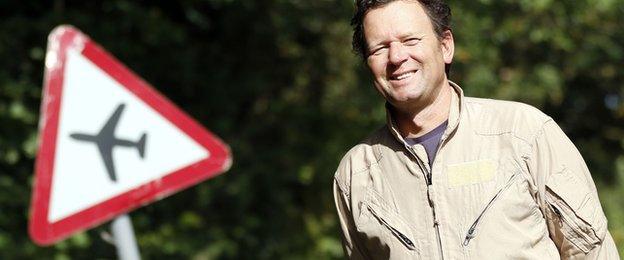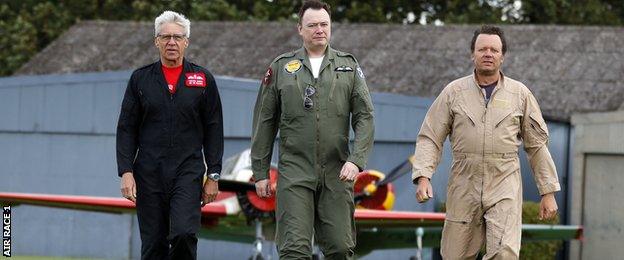Air Race 1 World Cup: Meet the Brits competing in the world's fastest motorsport
- Published
Meet England's high-flying World Cup contender
As Yves Clarke fell from the sky and crashed to earth, breaking his back and puncturing his lung, he decided that flying would best be done with wings and engine propelling him.
The crash ended the former builder's thrill-seeking ways as a paraglider and prompted him to earn his wings as an airline pilot.
And now, he is among a select group of pilots that will be going wing tip to wing tip in specially made Formula 1 planes at more than 250mph - and just 50ft off the ground - in pursuit of Air Race 1 World Cup glory.
"I always wanted to fly and the cheapest way when I was 17 was with a parachute on your back and jumping off mountains," Clarke told BBC Sport.
"I thought I'd give that a go and it went well for a year or so but I then had a bad accident in a competition, and hit ground quite hard and busted myself up.
"Engines and wings are better. I always wanted to have a proper wing. Fast aeroplanes are much more fun, much more stable, and much more reliable.

Yves Clarke will be making his competitive debut at the Air Race 1 World Cup
While the 46-year-old earns a living sat in the cockpit of a passenger jet, cruising at more than 30,000ft and 570mph, he gets his aeronautical kicks at the controls of the single-seater aircraft, zipping around in a field of eight planes at incredibly low altitudes in what is the world's fastest motorsport.
The Devon pilot is one of three Brits that will be taking to the skies over the U-Tapao Royal Thai Navy Air Base next month, with flying Scotsman and shipbroker Des Hart and 58-year-old former Royal Air Force top gun Trevor Jarvis also among the World Cup hopefuls.
"For any aviator, this has to be the peak, trashing around at 50ft at 250mph. It's awesome and addictive," said Clarke, who is the only rookie racer among the trio.
"It is not inherently dangerous, just unforgiving of bad preparation or poor airmanship. The training, coupled with experience of other pilots, makes it doable and safe."
To get on the start grid Clarke had to go through a gruelling training and testing programme in Reno, USA, a patch of the Nevada desert that is cherished as the Mecca of air racing.
Being an accomplished pilot is not enough to get a seat as a racer though, as the demands of getting around a circuit made up of six pylons in a oval shape and overtaking aircraft at high speeds are complex.
It is racing free as a bird, with infinite lines to overtake on - however, for safety reasons, manoeuvres can only take place on the outside.
"It is a busy place out there when racing," said 43-year-old Hart.
"You don't have a great deal of time to think about anything, other than getting the most performance out of your engine by adjusting fuel-air mixture, monitoring the engine instruments, flying the smoothest line you can and, if you have a guy in in front of you, how are you going to catch them and beat them? That is all that is going through my mind during a race.

Top guns Trevor Jarvis (left), Des Hart (centre) and Yves Clarke at Little Gransden Airfield in Bedfordshire
"Sure, it is an oval course, but it is more complicated than that as there is almost an infinite number of ways you can fly that course.
"You can fly a bit wider to pull less Gs, which slows the aircraft down, but you are covering more distance so it's a longer course, or you can fly tighter, pull more Gs and lose more energy, or you can fly higher or you can fly lower."
Hart, who once aspired to be a commercial pilot, is at ease whatever the demands. This being a man who is at home on land, at sea and in the air.
In Thailand it will be hot and humid racing, pushing man and machine to their limits.
"Dogged determination is what you need," said Hart.
"We are good friends on the ground in the hanger and then we get out there on the course and there are no friendships. We are racing, and racing hard."
'Race it like a Ferrari'
The air racing they will be doing in Thailand is nothing new, as the form of motorsport has been around for more than 70 years.
Aircraft competing are made to race.
Some of the F1 planes are even made at home, with £12,000 enough to get you started - which is a few million cheaper than their automobile namesakes.
While there are guidelines to be followed - with a minimum wing area, weight, specific engine type, fixed landing gear and fixed pitch propeller - there is plenty of room to experiment with design, and ways to make the engine churn out power.
Jarvis, an airline pilot who has had a flying career at the controls of everything from a Jet Provost to C-130 Hercules military carriers, says the ingenuity and competitive drive of pilots makes for spectacular racing.
"It is proper racing. It is not like formation flying - it's more aggressive than that," he said.
"These planes are pretty much designed to go racing, but you can use them to do touring.
"It is like a track day with a car, you can go buy a Ferrari or Aston Martin and do 70mph on the motorway, but with air racing you actually have the chance to use these things like a track day.
"This is where the fun is, you can race the plane as you would race a car on track day."
Jarvis, himself, will be taking the controls of Sonic Zoom, an American owned aircraft, while Hart is taking his plane, Sleeper, up for its maiden race.
Meanwhile, Clarke will be in the cockpit of Outrageous, a plane built in 1975.
"It is a good name, a fitting name - it behaves outrageously and hopefully it will be outrageously fast," said Clarke.